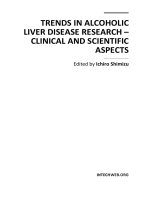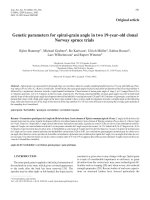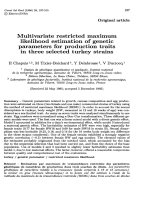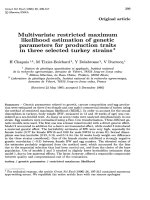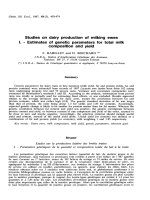Age-related trends in genetic parameters for Larix kaempferi and their implications for early selection
Bạn đang xem bản rút gọn của tài liệu. Xem và tải ngay bản đầy đủ của tài liệu tại đây (467.34 KB, 8 trang )
Lai et al. BMC Genetics 2014, 15(Suppl 1):S10
/>
PROCEEDINGS
Open Access
Age-related trends in genetic parameters for Larix
kaempferi and their implications for early
selection
Meng Lai, Xiaomei Sun, Dongsheng Chen, Yunhui Xie, Shougong Zhang*
From International Symposium on Quantitative Genetics and Genomics of Woody Plants
Nantong, China. 16-18 August 2013
Abstract
Background: Japanese larch (Larix kaempferi) has been introduced in China at the end of the 19th century, and as one
successful exotic species, is becoming the preferred coniferous in northern China and sub-tropical alpine region. The
rotation age is about 25-28 years for L. kaempferi as pulpwood in Henan province. Waiting for even one-half rotation
age for final evaluation will be inefficient due to accumulated testing costs and delayed return on investment, which
suggests that selection at an early age is highly desirable for L. kaempferi improvement programs in Henan province. In
this study, we determined age trends of genetic parameters and evaluated early selection efficiency for L. kaempferi in
Henan province to find out the appropriate trait for early selection and its selection age.
Results: Growth traits of 78 clones were measured periodically from age 2 to age 15 in a clonal trial of Larix
kaempferi establishted at Son town, Henan Province. The genetic variation among clones, age-age correlations, and
age trends in genetic parameters for growth traits were analyzed. Variant analysis revealed that tree height (HGT)
and diameter at breast (DBH) were significant (1% level) among clones at every ages. The clonal repeatability of
growth traits varied year-by-year, reaching the highest levels at different ages for different traits (0.77 at age 2 for
HGT, 0.70 at age 5 for DBH and 0.66 from age 8 to age 10 for volume, respectively). The age-age genetic
correlations ranged from 0.904 to 1.000 for HGT, and from 0943 to 1.000 for DBH. DBH at different ages was more
genetically correlated to volume-15 than HGT. At the phenotypic level, HGT was always less correlated to volume15 than DBH. With the estimates of efficiencies of early selection, the recommendation from present study was
that the optimum age of early selection was age 2 for HGT and age 5 for DBH.
Conclusions: Our study showed that there were significant (1% level) on growth traits among clones at every
ages. The genetic parameters for growth traits varied from age to age. We found dual trait selection was more
efficient than single trait selection for early selection.
Background
Larch (Larix sp.) is one of the most valuable conifers in
boreal and temperate forests as well as in mountainous
regions where it is either native or introduced in artificial
plantations [1]. It is of great ecological and economical
importance and is highly appreciated for wood properties
including high mechanical strength, attractive reddish
colour and high natural durability. Japanese larch (Larix
* Correspondence:
State Key Laboratory of Tree Genetics and Breeding, Research Institute of
Forestry, Chinese Academy of Forestry, Beijing 100091, China
kaempferi) has been introduced in China at the end of
the 19th century, and as one successful exotic species, is
becoming the preferred coniferous in northern China
and sub-tropical alpine region due to its superior performance on fast-growing at early ages, higher wood specific
gravity, comparable fiber length, pest resistance and wide
adaptation [2]. As a result, the area of Japanese larch
plantation has been over 0.3 million hectares in China,
and has been increasing at a speed of 300 thousand hectares annually.
© 2014 Lai et al.; licensee BioMed Central Ltd. This is an Open Access article distributed under the terms of the Creative Commons
Attribution License ( which permits unrestricted use, distribution, and reproduction in
any medium, provided the original work is properly cited. The Creative Commons Public Domain Dedication waiver (http://
creativecommons.org/publicdomain/zero/1.0/) applies to the data made available in this article, unless otherwise stated.
Lai et al. BMC Genetics 2014, 15(Suppl 1):S10
/>
The rotation age is about 25-28 years for L. kaempferi
as pulpwood in Henan province. Waiting for even onehalf rotation age for final evaluation will be inefficient
due to accumulated testing costs and delayed return on
investment, which suggests that selection at an early age
is highly desirable for L. kaempferi improvement programs in Henan province.
Age trends for genetic parameters are crucial for developing tree breeding strategy and early selection [3]. A
number of studies have documented age trends in these
parameters for loblolly pine (Pinus. taeda) [4-9], Scots pine
(P. sylvestris) [10-12], maritime pine (P. pinaster) [13], lodgepole pine (P. contorta) [14,15], jack pine (P. banksiana)
[16,17,3], and Douglas-fir (P. menziesii) [18,19]. However,
relatively few authors have addressed trends over time in
genetic parameters for L. kaempferi. After the analyses of
age trends in heritability, juvenile-mature correlations and
genetic gains, Sun et al. [20] found that the most proper
age for early selection was age 6, and diameter was a better
predictor than height due to its genetic stability. In a clonal
trail of L. kaempferi in northern China, Ma et al. [26]
found that the Lambeth model generally fit genetic correlations well, and the highest selection efficiency for height
was achieved at age 10 by using height at age 20 as selection criterion. The objectives of the study were, on the
basis of a clonal trail of L. kaempferi that included 78
clones, (1) to determine age trends of genetic parameters,
(2) to estimate age-age correlations for HGT and DBH,
(3) to estimate age-age correlations for HGT and DBH
with VOL-15, (4) to evaluate early selection efficiency for
L. kaempferi in Henan province.
Methods
Trial description
The data were collected from a clonal trial established at
Son town in Henan (34°14’N, 112°07’E), and with annual
mean temperature of 8.6°C and annual rainfall of 8001200mm. Minimum January temperature and maximum
July temperature at this region were -15.5°C and 24.7°C,
respectively. The soil was brown earth and pH = 6.0. 78
L. kaempferi clones were planted in the spring of 1998.
Field design was randomized complete blocks with four
replications and 4-tree plot in a spacing of 2 m × 2 m.
Data collection
Diameter at breast (DBH) and height (HGT) were measured for all trees. HGT was measured from 2 to 15 yeas
after planting, and DBH was measured from 5 to 15 years
after planting. The traits analysed in this study were
referred to as DBH-8, HGT-4 etc, the numbers indicating
the ages. Individual tree volume (VOL in m3) was calculated using the following tree volume formula [22]:
VOL = 0.0000592372 × DBH1.8655726 × HGT0.98098962 (1)
Page 2 of 8
Statistical analysis
In this study, a nonlinear mixed model by using
Richards growth function as basic model was constructed to fit the relationship for first-hand data of
growth traits on age.
Richards growth function was as followed:
Y = a(1 − e−bT )c
(2)
Where Y is height (HGT) or diameter at breast
(DBH), a, b and c are parameters, and T is the age of
the trees.
Nonlinear mixed model was as followed:
Y = (a + υL + υR ) 1 − e−(b+ωL +ωR )T
c
+ε
(3)
Where υL and υR, and ωL and ωR are random coefficients at the clone and replication levels for a and b,
respectively, and c was not allowed to vary randomly.
The variance-covariance structures were positive-definite
at both the clone L and replication R levels, and specified as:
L
=
2
συL
2
συωL
and
2
2
συωL
σωL
R
=
2
συR
2
συωR
2
2
συωR
σωR
(4)
and distributed bivariate normally with normal random errors:
E
E
υL
ωL
υR
ωR
=0
υαr
=0
υαr
υL
ωL
υR
ωR
=
=
ε ∼ N 0, σ 2
2
συL
2
συωL
2
2
συωL
σωL
2
συR
2
συωR
2
2
συωR
σωR
(5)
At every age, variation among clones, variance components, and genetic p��������������������������������������������������������������������������������������������������������������������������������������������������������������������������������������������������������������������������������������������������������������������������������������������������������������������������������������������������������������������������������������������������������������������������������������������������������������������������������������������������������������������������������������������������������������������������������������������������������������������������������������������������������������������������������������������������������������������������������������������������������������������������������������������������������������������������������������������������������������������������������������������������������������������������������������������������������������������������������������������������������������������������������������������������������������������������������������������������������������������������������������������������������������������������������������������������������������������������������������������������������������������������������������������������������������������������������������������������������������������������������������������������������������������������������������������������������������������������������������������������������������������������������������������������������������������������������������������������������������������������������������������������������������������������������������������������������������������������������������������������������������������������������������������������������������������������������������������������������������������������������������������������������������������������������������������������������������������������������������������������������������������������������������������������������������������������������������������������������������������������������������������������������������������������������������������������������������������������������������������������������������������������������������������������������������������������������������������������������������������������������������������������������������������������������������������������������������������������������������������������������������������������������������������������������������������������������������������������������������������������������������������������������������������������������������������������������������������������������������������������������������������������������������������������������������������������������������������������������������������������������������������������������������������������������������������������������������������������������������������������������������������������������������������������������������������������������������������������������������������������������������������������������������������������������������������������������������������������������������������������������������������������������������������������������������������������������������������������������������������������������������������������������������������������������������������������������������������������������������������������������������������������������������������������������������������������������������������������������������������������������������������������������������������������������������������������������������������������������������������������������������������������������������������������������������������������������������������������������������������������������������������������������������������������������������������������������������������������������������������������������������������������������������������������������������������������������������������������������������������������������������������������������������������������������������������������������������������������������������������������������������������������������������������������������������������������������������������������������������������������������������������������������������������������������������������������������������������������������������������������������������������������������������������������������������������������������������������������������������������������������������������������������������������������������������������������������������������������������������������������������������������������������������������������������������������������������������������������������������������������������������������������������������������������������������������������������������������������������������������������������������������������������������������������������������������������������������������������������������������������������������������������������������������������������������������������������������������������������������������������������������������������������������������������������������������������������������������������������������������������������������������������������������������������������������������������������������������������������������������������������������������������������������������������������������������������������������������������������������������������������������������������������������������������������������������������������������������������������������������������������������������������������������������������������������������������������������������������������������������������������������������������������������������������������������������������������������������������������������������������������������������������������������������������������������������������������������������������������������������������������������������������������������������������������������������������������������������������������������������������������������������������������������������������������������������������������������������������������������������������������������������������������������������������������������������������������������������������������������������������������������������������������������������������������������������������������������������������������������������������������������������������������������������������������������������������������������������������������������������������������������������������������������������������������������������������������������������������������������������������������������������������������������������������������������������������������������������������������������������������������������������������������������������������������������������������������������������������������������������������������������������������������������������������������������������������������������������������������������������������������������������������������������������������������������������������������������������������������������������������������������������������������������������������������������������������������������������������������������������������������������������������������������������������������������������������������������������������������������������������������������������������������������������������������������������������������������������������������������������������������������������������������������������������������������������������������������������������������������������������������������������������������������������������������������������������������������������������������������������������������������������������������������������������������������������������������������������������������������������������������������������������������������������������������������������������������������������������������������������������������������������������������������������������������������������������������������������������������������������������������������������������������������������������������������������������������������������������������������������������������������������������������.86
5
5.86E-08
1.34E-07
9.21E-08
58.33
0.64
95.99
6
4.18E-07
9.28E-07
6.50E-07
53.88
0.64
89.13
7
1.72E-06
3.68E-06
2.64E-06
49.87
0.65
83.04
8
9
4.85E-06
1.05E-05
1.02E-05
2.18E-05
7.40E-06
1.60E-05
46.56
43.73
0.66
0.66
77.76
73.20
10
1.87E-05
3.93E-05
2.85E-05
41.58
0.66
69.45
11
2.93E-05
6.20E-05
4.48E-05
39.51
0.65
65.92
12
4.12E-05
8.87E-05
6.34E-05
37.54
0.65
62.44
13
5.37E-05
1.18E-04
8.32E-05
36.28
0.65
60.13
14
6.62E-05
1.48E-04
1.03E-04
35.07
0.64
57.95
15
7.79E-05
1.79E-04
1.23E-04
34.21
0.64
56.24
at age 2 to 8.25 m at age 15, the DBH increased from
1.50 cm at age 5 to 7.94 cm at age 15, and the VOL
increased from 0.000415 m3 at age 5 to 0.0258 m3 at
age 15. Meanwhile, the annual HGT increment was a
mean of 0.60 m, the annual average DBH and VOL
increment were 6.4 mm and 0.002538 m3, respectively.
The results of the analysis of variance for growth traits
showed that there were significant differences (1% level)
on HGT, DBH and VOL among clones at every age,
indicating that there were great potential for genetic
improvement of growth traits among clones.
DBH
VOL
Lai et al. BMC Genetics 2014, 15(Suppl 1):S10
/>
Page 5 of 8
13.61 and 22.47 percent for DBH and between 34.21 and
58.33 percent for VOL. For all ages, the CVG of VOL was
higher than those of HGT and DBH, and the CVG of
DBH was higher than the CVG of HGT at the same age.
A decreasing trend with age for growth traits was found
for CVG in our studies.
The clonal repeatability ranged from 0.64 to 0.77 for
HGT with the highest occurring at age 2, from 0.66 to
0.70 for DBH with the highest occurring at age 5, and
from 0.64 to 0.66 for VOL with the highest occurring
from age 8 to age 10. On the whole, the clonal repeatability of HGT and DBH were decreased with ageing, as the
clonal repeatability of VOL increased from 0.64 at age
5 to 0.66 at age 8, keep it at this level until age 10, and
then decreased again. Time trends in genetic gains for
grow traits among clones selection, with 5% selection
rate (or intensity = 2.063), showed that the greatest gains
were reached at age 2 for HGT and age 5 for both DBH
and VOL.
Estimated age-age genetic correlations between HGT
at different ages and HGT-15 varied from 0.904 to 1.000
(table 4). The corresponding estimated age-age phenotypic correlations ranged from 0.887 to 1.000. Age-age
genetic correlations for DBH varied from 0.943 to 1.000.
For all ages, the DBH were more genetically correlated
to DBH-15 than HGT to HGT-15. Phenotypic correlations for DBH ranged from 0.905 to 1.000, and were
generally lower than corresponding genetic correlations
estimates for all ages. As the age difference decreased,
both the age-age genetic and phenotypic correlations for
HGT or DBH increased.
Table 4 Estimated genetic correlations (rg) and
phenotypic correlations (rp), for height at age 15 (HGT15) with various heights, and diameter at age 15 with
various diameters.
Age
HGT
DBH
Estimated of genetic correlations and phenotypic correlations between VOL-15 and various HGT or DBH
are listed in table 5. The genetic and phenotypic correlations involving VOL-15 and various HGT increased with
ageing, and the values ranged from 0.849 to 1.000. The
same trend was observed for genetic and phenotypic
correlations between VOL-15 and various DBH (rang
0.897-1.000). It is evident that the genetic correlations
between DBH and VOL-15 were stronger than corresponding correlations with HGT at the same age. At the
phenotypic level, HGT was always less correlated to
VOL-15 than DBH.
Efficiencies of early selection
The efficiencies of early selection (Qyear) in growth traits at
age 15, through early selection on various HGT and DBH,
are shown in Figure 1 and 2, respectively. Although the
magnitudes of the selection efficiency varied with time,
study indicated that selection made at the first measurement year would be more efficient than direct growth
traits selection at age 15. That is, indirect selection on
HGT-2 and DBH-5 could be expected to produce the
most gain per year in growth traits at age-15 compared
with direct selection on HGT and DBH themselves.
Discussion
The variance components, genetic variation coefficients
(CVG), clonal repeatability (R) and genetic gains (ΔG) for
growth traits are dynamic during whole period of tree
growth and show some certain rules. An increasing trend
with age of variance components for growth traits was
found in this study, this trend in variance components
Table 5 Estimated genetic correlations (rg) and
phenotypic correlations (rp), for tree volume at age-15
(VOL-15) with various heights or diameters.
Age
HGT
DBH
rg
rp
rg
rp
rg
rp
rg
rp
2
0.904
0.887**
-
-
2
0.882
0.849**
-
-
3
0.917
0.906**
-
-
3
0.890
0.867**
-
-
4
0.928
0.920**
-
-
4
0.917
0.879**
-
-
5
6
0.939
0.950
0.934**
0.947**
0.943
0.956
0.905**
0.926**
5
6
0.919
0.926
0.889**
0.899**
0.923
0.935
0.897**
0.912**
7
0.960
0.958**
0.966
0.944**
7
0.942
0.908**
0.943
0.925**
8
0.970
0.969**
0.976
0.960**
8
0.944
0.915**
0.952
0.936**
9
0.978
0.977**
0.983
0.973**
9
0.955
0.922**
0.960
0.945**
10
0.985
0.985**
0.989
0.983**
10
0.955
0.927**
0.964
0.951**
11
0.990
0.990**
0.994
0.990**
11
0.964
0.930**
0.965
0.955**
12
0.995
0.995**
0.997
0.995**
12
0.964
0.932**
0.971
0.957**
13
14
0.997
0.999
0.997**
0.999**
0.999
1.000
0.998**
0.999**
13
14
0.964
0.969
0.933**
0.934**
0.971
0.972
0.958**
0.958**
15
1.000
1.000**
1.000
1.000**
15
0.969
0.934**
0.972
0.958**
**Significant at 0.01 level.
**Significant at 0.01 level.
Lai et al. BMC Genetics 2014, 15(Suppl 1):S10
/>
Figure 1 Selection efficiency (Qyear) for HGT, expressed as the
ratio of correlated response in growth traits at age 15 from a
selection on various heights.
was similar to those found in Norway spruce [25] and
Scots pine [10].
Grasping the age trends of genetic variation coefficients, clonal repeatability and genetic gains are very
important for determining the appropriate early selection
Figure 2 Selection efficiency (Qyear) for DBH, expressed as the
ratio of correlated response in growth traits at age 15 from a
selection on various diameters.
Page 6 of 8
time and estimating the effects of early selection [26].
The coefficients of genetic variation (CVG), that is, the
genetic variance standardized to trait mean, is considered
to be the most suitable parameter for comparisons of
genetic variation and the ability to respond to natural or
artificial selection [27]. In the present study, the CVG of
VOL was higher than the CVG of HGT or DBH at the
same age, agreeing with previous study of jack pine
which revealed that the CVA (additive genetic coefficient
of variation) for volume, at one-half rotation age was
almost 2-3 times higher as that for height [3]. Besides,
the CVG of DBH was higher than the CVG of HGT at
the same age, indicating that the scope for selection
among clones of DBH is larger than that for HGT. The
CVG for growth traits decreased with ageing, with
regarded to the CVA, similar trend has been reported in
other studies [10,11,28,29].
Clonal repeatability estimates for growth traits in this
study ranged from 0.64 to 0.77, which means that variation in growth traits of L. kaempferi were controlled
genetically at medium or upwards level. As a whole, the
clonal repeatability of HGT decreased with ageing, agreeing with previous study by Vasquez and Dvorak [30].
Vasquez and Dvorak [30] investigated the trend of heritability for height in tropical pine species during first
8 years of growth, and found that in P. tecunumanii and
P. chiapensis the heritability of height was decreased with
aging. However, Xiang et al. [8] found that the general
trend of heritability estimates was increasing over time.
Danjon [31] found that the heritability of height in
P. pinaster increased after 5 years and remained fairly
constant after age 10 years. The clonal repeatability of
DBH followed a similar trend over time as HGT, which
decreased with increasing age, in agreement with former
finding in lodgepole pine [15]. Nevertheless, with regard
to the heritability in other studies, Jonson et al. [18]
found that the heritability of diameter showed an
increase with aging for Douglas-fir while the heritability
of height was mostly stable over time. Xiang et al. [8]
reported that the heritability of diameter increased from
age 4 to age 8. The clonal repeatability of VOL was
mostly stable over time, ranging from 0.64 to 0.66, the
values of clonal repeatability for VOL were a few points
lower than those of HGT and DBH, reflecting the influence of HGT and DBH on VOL.
Age-age genetic correlations for HGT or DBH in this
study were impressive high, and the results suggest that
the genes involved in early age HGT or DBH growth
appear to be similar to those affecting the same trait at age
15. The age-age genetic correlations for DBH were stronger than those of HGT for all ages, differed from those of
Gwaze and Bridgewater [6] who revealed that at young
ages (<8 years) height was more genetically correlated to
height at 25 years than diameters to diameter at 25 years.
Lai et al. BMC Genetics 2014, 15(Suppl 1):S10
/>
Dean and Stonecypher [19] found that, from age 5 to age
10, the genetic correlations involving height and height-17
were stronger than the genetic correlations between diameter and diameter-17 at the same age.
Age-age genetic correlations between various HGT or
DBH and VOL at age 15 (VOL-15) were strong. In general, the age-age genetic correlations presented here are
similar to other findings in Douglas-fir [18], Norway
spruce [25]. The age trend of age-age genetic correlations
between various HGT and VOL-15 was similar to the age
trend of genetic correlations between various DBH and
VOL-15, which increased with ageing. The results in this
study were different from the observations in loblolly
pine, in which Xiang et al. [8] reported that the shape of
the trend curve over time for genetic correlations of trait
height with age-8 volume was different than the corresponding curve for genetic correlations of trait diameter
with age-8 volume. Age-age genetic correlations between
the various HGT and VOL-15 were lower than those
between DBH and VOL-15 for all ages. Our results in
agreement with those of Li and Mckeand [32] who found
that genetic correlations between various heights and
volume at age 20 were always lower than those of
between the various diameters and volume at age 20.
However, Gwaze and Bridgewater [6] found that at
young ages (< 7 years) height was more genetically correlated to volume at 25 years than diameter.
It is believed that the age when efficiency of early selection reached the maximum value was the optimum age
for early selection [33]. In this study we have used growth
traits at age 15 as the selection criterion, results in the
present study indicate that early selection for L. kaempferi in Henan province could be effective. High genetic
correlations between growth traits at age 15 and various
HGT or DBH should explain the observation. In our studies, the optimum selection age for HGT using growth
traits at age 15 as selection criterion (age 2) was 3 years
lower than those for DBH using growth traits at age 15
as selection criterion (age 5). Although the highest selection efficiency was achieved at the first measurement
year, i.e., age 2 for HGT and age 5 for DBH, the true
optimal age could potentially be even earlier. Optimum
selection age for DBH in this study was slightly lower
those estimated by Sun et al. [20] and Ding et al. [34]
(6-7 years for family selection). A latter early selection
age for HGT of L. kaempferi was found in the study of
Ma et al. [21], in which the optimum age of early selection for HGT was age 10 in northern of China.
Some researchers thought the superiority of height for
early selection was due to its higher heritability than
diameter [35-37]. However, Li and Mckeand [32]
inferred that optimum selection age for diameter was
likely to be lower than that of height given the higher
age-age correlations and the comparable heritability
Page 7 of 8
estimates, and thus diameter should be more effective
than height as the trait for early selection. In this study,
the efficiencies (Q year ) of early selection on HGT at
young ages (< 10 years) in terms of indirect gains per
year in vol-15 were higher than those for DBH, suggesting that HGT might be a better early selection criterion
than DBH. However, with the analyses of age trends for
HGT and DBH in genetic parameters, we found DBH
was a better predictor than HGT. These results indicate
that dual trait selection might be more reliable than single trait selection for early selection, agreeing well with
results for China fir (Cunninghamia. Lanceolata) published elsewhere [21,38].
The strength of this study is that the population sample size was large (78 clones) and a nonlinear mixed
model was used to fit the relationship for first-hand
data of HGT and DBH on age, therefore allowed reasonably precise genetic statistics and realistic predictions
of rotation age gains. However, the study is limited by
the fact that it was established at only one site. The
genetic parameters and age-age correlations have been
shown to differ among sites or geographic regions [3,4].
Conclusions
In conclusion, there were significant differences (1%
level) on growth traits among clones at every ages. The
genetic parameters for growth traits varied from age to
age. The genetic correlations involving VOL-15 and various HGT or DBH increased with ageing, and HGT was
always less correlated to VOL-15 than DBH at the
genetic level. Using growth traits at age 15 as the selection criterion, the highest selection efficiency was
achieved at the first measurement year, thus the optimal
selection age was age 2 for HGT and age 5 for DBH,
and dual trait selection was more efficient than single
trait selection for early selection.
Competing interests
The authors declare that they have no competing interests.
Authors’ contributions
ML conducted the study and wrote the manuscript. XM Sun carried out the
critical reading and grammatical correction of manuscript. SG Zhang was
mainly responsible for who gained the fund providing the study need. DS
Chen and YH Xie participated in discussions and helped to draft the
manuscript. All authors read and approved the final manuscript.
Acknowledgements
The authors gratefully thank professor CG Ma for providing review
comments on early draft of this paper, K Zhao from Luoyang Forest Institute
for his painstaking in data collection. This work was supported by the
National Science & Technology Pillar Program in the Twelfth Five-Year Plan
Period of China (2012BAD01B01).
Declarations
Publication charges for this work were funded by a grant from the National
Science & Technology Pillar Program in the Twelfth Five-Year Plan Period of
China (2012BAD01B01).
Lai et al. BMC Genetics 2014, 15(Suppl 1):S10
/>
This article has been published as part of BMC Genetics Volume 15
Supplement 1, 2014: Selected articles from the International Symposium on
Quantitative Genetics and Genomics of Woody Plants. The full contents of
the supplement are available online at />bmcgenet/supplements/15/S1.
Published: 20 June 2014
References
1. Pâues LE, García-Casas MdC, Charpentier JP: Distribution of heartwood
extractives in hybrid larches and in their related European and Japanese
larch parents: relationship with wood colour parameters. European
Journal of Forest Research 2013, 132:61-69.
2. Sun XM, Zhang SG, Zhou DY, Wang XD, Ding B, Liu SM: Phenological
variation of Larix species and their intra-species and inter-species hybrid
families and early selection. Scientia Silvae Sinicae 2008, 44(1):77-84.
3. Weng YH, Tosh KJ, Park YS, Fullarton MS: Age-related trends in genetic
parameters for Jack Pine and their implications for early selection. Silvae
Genetica 2007, 56(5):242-251.
4. Gwaze DP, Bridgwater PE, Byram TD, Woolliams JA, Williams CG: Predicting
age-age genetic correlations in tree-breeing programs: a case study of
Pnius taede L. Theoretical and Applied Genetics 2000, 100:199-206.
5. Lambeth CC, Dill LA: Prediction models for juvenile-mature correlations
for loblolly pine growth traits within, between and across test sites.
Forest Genetics 2001, 8:101-108.
6. Gwaze DP, Bridgwater PE: Determining the optimum selection age for
diameter and height in loblolly pine. Forest Genetics 2002, 9:159-165.
7. Atwood RA, White TL, Huber DA: Genetic parameters and gains for
growth and wood properties in Florida source loblolly pine in the
southeastern united states. Canadian Journal of Forest Research 2002,
32(6):1025-1038.
8. Xiang B, Li B, Isik F: Time Trend of Genetic Parameters in Growth Traits of
Pinus taeda L. Silvae Genetica 2003b, 52(3-4):114-121.
9. Xiang B, Li B, Mckeand S: Genetic gain and selection efficiency of loblolly
pine in three geographic regions. Forest science 2003a, 49(2):196-208.
10. Haapanen M: Time trends in genetic parameter estimates and selection
efficiency for Scots pine in relation to field testing method. Forest
Genetics 2001, 8:129-144.
11. Jansson G, Li B, Hannrup B: Time trends in genetic parameters for height
and optimum age for parental selection in Scots pine. Forest Science
2003, 49:696-705.
12. Kroon J, Ericsson T, Jansoon G, Andersoon B: Patterns of genetic
parameters for height in field genetic tests of Picea abies and Pinus
sylvestris in Sweden. Tree Genetics & Genomes 2011, 7:1099-1111.
13. Kusnandar D, Gwalwey N, Hertzler GL, Butcher TB: Age trends in variance
and heritabilities for diameter and height in maritime pine (Pinus
pinaster) in western Australia. Slivae Gnetica 1998, 47:136-141.
14. Xie CY, Ying CC: Heritabilities, age-age correlations, and early selection in
lodgepole pine (Pinus contorta ssp. latifolia). Silvae Genetica 1996,
45:101-107.
15. Chen XY, Hawkins B, Xie CY, Ying CC: Age trends in genetic parameters
and early selection of lodgepole pine provenances with particular
reference to the lambeth model. Forest Genetics 2003, 10(3):249-258.
16. Riemenschneider DE: Heritability, age-age correlations, and inference
regarding juvenile selection in jack pine. Forest Science 1988,
34:1076-1082.
17. Carter KK, Adams GW, Greenwood MS, Nitschke P: Early family selection in
jack pine. Canadian Journal of Forest Research 1990, 20:168-175.
18. Jonson GR, Sniezko RA, Mandel NL: Age trends in Douglas-fir genetic
parameters and implications for optimum selection age. Silvae Genetica
1997, 46(6):349-358.
19. Dean CA, Stonecypher RW: Early selection of Douglas-Fir across south
central Coastal Oregon. USA. Silvae Genetica 2006, 55(3):135-141.
20. Sun XM, Zhang SG, Hou YM, Li SY: Age trends of genetic parameters for
growth traits in short rotation Larix kaempferi families. Scientia Silvae
Sinicae 2004, 40(6):68-74.
21. Ma CG, Zhou TX, Xu JL: A preliminary study on genetic control of growth
traits and early selection for Chinese fir (Cunninghamia lanceolata)
clones. Scientia Silvae Sinicae 2000, 36:62-69.
Page 8 of 8
22. Sun XM: Selection of superior Larix kaempferi families for pulpwood
purpose and family-based growth simulation. Ph. D. Dissertation, Chinese
Academy of Forestry, Beijing; 2003, 40.
23. Hansen JK, Roulund H: Genetic parameters for spiral grain, stem form,
Pilodyn and growth in 13 year old clones of Sitka Spruce (Picea
sitchensis (Bong.) Carr.). Silvae Genetica 1996, 46(2-3):107-113.
24. Hai PH, Jansson G, Harwood C, Hannrup B, Thinh HH: Genetic variation in
growth, stem straightness and branch thickness in clonal trials of Acacia
auriculiformis at three contrasting sites in Vietnam. Forest Ecology and
Management 2008, 255:156-157.
25. Isik K, Kleinschmit J, Steiner w: Age-age correlations and early selection
for height in a clonal genetic test of Norway spruce. Forest science 2010,
56(2):212-221.
26. Ma SX: Studies on genetic variation and early selection of Japanese larch
clones. M. S. Dissertation, Henan Agricultural University, Zhengzhou; 2006,
35.
27. Houle D: Comparing evolvability and variability of quantitative traits.
Genetics 1992, 130:195-204.
28. Costa P, Durel CE: Time trend in genetic control over height and
diameter in maritime pine. Canadian Journal of Forest Research 1996,
26:1209-1217.
29. King JN, Burdon RD: Time trends in inheritance and projected efficiencies
of early selection in a large 17-year-old progeny test of Pinu sradiata.
Canadian Journal of Forest Research 1991, 21(8):1200-1207.
30. Vasquez J, Dvorak WS: Trend in variance and heritabilities with stand
development of tropical pines. Canadian Journal of Forest Research 1996, ,
26: 1473-1480.
31. Danjon F: Heritability and genetic correlations for estimated growth
curve parameters in maritime pine. Theoretical. Applied. Genetics 1994,
89:911-921.
32. Li B, Mckeand SE: Genetic parameter estimates and selection efficiency
for the loblolly pine breeding in south-eastern U.S. In Tree improvement
for sustainable tropical forestry. Queensland, Australia;Dieters M J, Matheson
A C, Nikles D G 1996:164-168.
33. Kang H: Juvenile selection in tree breeding: some mathematical models.
Silvae Genetica 1985, 34(2-3):75-84.
34. Ding ZF, Wang JZ, Fang HF, Wang LB, Yu JL, Zou LY, Li CP: The early stage
selection technology for family system of Larix olgensis. Journal of
Northeast Forest University 1997, 25(3):65-67.
35. Forster GS: Trends in genetic parameters with stand development and
their influence on early selection for volume growth in loblolly pine.
Forest Science 1986, 32(4):944-959.
36. Lambeth CC, Vanbuijtenen JP, Duke SD: Early selection is effictive in 20year-old genetic tests of loblolly pine. Silvae Genetica 1983, 32(56):210-215.
37. Balocchi CE, Bridgwater FE: Age trend in genetic parameters for tree
height in a non-selected population of loblolly pine. Forest Science 1993,
39:231-251.
38. Zhao CK: A study on optimum age and gain for early selection of
superior clone in Cunninghamia lanceolata. Scientia Silvae Sinicae 2002,
38(4):53-60.
doi:10.1186/1471-2156-15-S1-S10
Cite this article as: Lai et al.: Age-related trends in genetic parameters
for Larix kaempferi and their implications for early selection. BMC
Genetics 2014 15(Suppl 1):S10.

